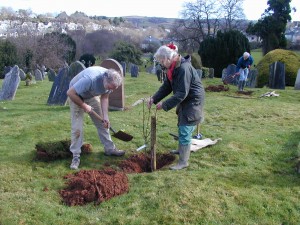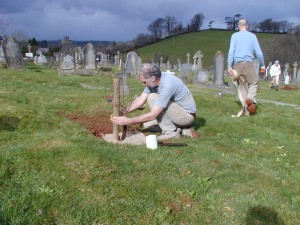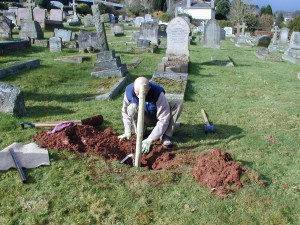17 Apr 2009
An Update on Totnes Nut Tree Plantings
 Here is an excellent update on the nut tree plantings taking place in Totnes, those of you doing similar things in your communities might find this useful…. my thanks to Wendy for documenting this.
Here is an excellent update on the nut tree plantings taking place in Totnes, those of you doing similar things in your communities might find this useful…. my thanks to Wendy for documenting this.
Background:
TTT started a nut tree planting scheme in Totnes in March 2007, with the planting of a few varieties of nut trees on Vire island. The vision behind this scheme is to provide another source of nutritious food for the community in the future.
During the winter of 2007-2008 further plantings happened on Longmarsh, Borough park playing fields, Follaton gardens and several sites in Bridgetown. Some people volunteered to be guardians of the trees, to watch their growth, and nurture them.
Most of them have survived, despite a lot of flooding on Longmarsh, and some battering of trees surrounding playing fields in Bridgetown.
This winter’s planting 2008/2009:
On December 14th 2008, a small group of residents of Meadow Close in Bridgetown, including several children, planted a new orchard of apples and pears and almonds on a site adjacent to the close. The process was helped along by mulled wine and mince pies! West Country Housing provided the funding for the trees and Tor Homes provided the stakes and mulch.
The weather was kind to us on a further planting day took place on Jan.24th 2009, a combined effort between our TTT nut tree planting project and Trees for Health and South Hams District Council.
 About 20 of us joined in planting more trees in Follaton Gardens, mulching some of the ones planted last year, and putting in 3 almond trees in the Town Cemetery. We were specially glad of the help of 2 children, Esben and Reuben, and hope they will enjoy telling their grandchildren about the putting in of all the huge sweet chestnut and walnut trees that will be flourishing in those gardens in 70 years time!
About 20 of us joined in planting more trees in Follaton Gardens, mulching some of the ones planted last year, and putting in 3 almond trees in the Town Cemetery. We were specially glad of the help of 2 children, Esben and Reuben, and hope they will enjoy telling their grandchildren about the putting in of all the huge sweet chestnut and walnut trees that will be flourishing in those gardens in 70 years time!
On Sunday March 1st 2009, we had another sunny planting day on Longmarsh, putting in more sweet chestnuts and walnuts and hazel trees. The indefatigable Esben helped us again, and a small group of adults also helped Tim Pollard [SHDC] and Liz Turner [Trees for Health] and me. We were reminded by a man who spends much time on Longmarsh that the shading of the Longmarsh meadow site when the nut trees grow big, will banish some of the more sun-loving plants. In deference to his knowledge of this site, we avoided a patch of meadow where orchids have been spreading the last few years. Hard decisions for us to make for future generations between the flourishing of all species of plants, and more specifically the ones that are useful to us humans.
On the same day, we re-planted 4 trees on the Pathfields playing field that had got damaged last year, with help of 2 boys, Alhor and Jordan, who both overlook the playing field from their homes and play on it.
On Mar.4th. a small but strong group of us planted another 7 fruit trees on the Town Cemetery site amongst the old graves. These are all potential Memorial trees for anyone who wants to buy one from the Town Council in memory of their dead friends or relatives. Liz Turner again supported us, and Tim Pollard, with equipment, and Ruth Robinson, Town Councillor, who has given much support to the Nut and fruit tree planting scheme, was there to photograph our labours!
 The last tree planting of the season was undertaken by the residents of Sparrow road, who planted nut trees on their road on Mar.13th.
The last tree planting of the season was undertaken by the residents of Sparrow road, who planted nut trees on their road on Mar.13th.
The response to our appeal for donors towards nut trees this year was fantastic. Many thanks to all individuals who have donated, and to South Hams District Council and West Country Housing association.
We are left with some funds towards next year’s planting.
Future plans:
1] We have become more aware this year, Teresa Anderson and I, that the number of sites for planting more big nut trees within the town, are rapidly shrinking, even on Longmarsh and Follaton gardens, and certainly in the residential areas.
There is still some potential for more planting of smallish trees, almonds and some fruit trees, within residential areas, where the folk living them may welcome the food source without being too shaded out.
2] Perhaps more individuals, farms, landowners with land around Totnes might be interested in planting more big nut trees on their land, the fruits of which can ultimately be sold or bartered ?
3] A more integrated approach to edible planting within the town boundaries,[ small trees, shrubs, climbers], may evolve between all interested parties to making Totnes a more attractive, green, and fruitful place. When the time is ripe, many of those with responsibilities for highways and open spaces and tourism and trade, as well as residents, may need to come together to envisage this and work towards it, if it is what we all want.
4] More people always welcome to join this project. Anyone who wants to join in the Tree planting scheme, or sponsor a tree, or be a tree guardian, please contact either Teresa Anderson on teresa (at) gaianet.org, or Wendy Stayte, at wendystayte (at) yahoo.co.uk
Wendy Stayte
Brad K.
17 Apr 6:43pm
I wonder – when planting trees in open areas – how to you evaluate the effect on ground water, the water table, and water availibility in nearby (without 1/4 mile) wells?
Locally I have several neighbors that found their wells going dry or not providing sufficient water. Cutting down 4 mature pecan trees (northern Oklahoma) restored three of the wells within a few weeks.
I know New Mexico closely regulates how many wells are allowed to operate in the state, how much water can be extracted, etc. And other places, including Oklahoma, have rules about wells that are seldom enforced.
Trees can be used deliberately to recover soggy ground. They can also interfere with other plants where water is scares.
All that said, planting trees for long term usage makes a lot of sense – especially when I read that Brazil reports “only” 1,000 square miles of rainforest were destroyed last year.
Greenpa
18 Apr 2:29pm
Big trees are grand- but have their problems. Besides space- they often take more years to bear; and once they are big, then can threaten near by housing, and require professional tree people to cope with it all.
Hazels can be used for hedges- and kept small by coppicing for fuelwood or craft wood. And, it’s worth remembering; the early people in the British Isles ALL relied heavily on hazels for food. Not only because they were native, I think; but more broadly adapted and reliable.
DaveDann
18 Apr 8:12pm
It’s worth remembering too that the people of the British Isles did not have a significant population of grey squirrels till about 1930. Also that the act of coppicing probably made nut collection viable.
Jim
19 Apr 2:21am
OT, but of interest:
The New York Times Sunday Magazine has a good length article on the Transition movement at
http://bit.ly/ULtwo
This is one of the first articles in the US press, and this is one of the more prominent platforms in the US.
Dave Crossland
19 Apr 10:45am
@Jim: That is the UK Sunday Times!
Dave Crossland
19 Apr 7:56pm
http://www.nytimes.com/2009/04/19/magazine/19town-t.html?pagewanted=all is the NY Times article
Redemption Blues » Britblog Roundup 218
20 Apr 8:44pm
[…] Wendy Stayte at Transition Culture shows us the softer side of the environmental movement, providing An Update on Totnes Nut Tree Plantings. […]
Peter Bralesford
21 Apr 7:05pm
I agree with Greenpa. Big trees are rather majestic, but they are pretty high maintenance, and come with a heap of problems if you aren’t careful. That said, I’ve heard something about a productive forest that needs no maintenance at all…
I’ve done a bit of productive tree planting myself, and I opted to use dwarf fruit varieties, because of the relatively short length of time that they take to mature. I’m wondering what the viability of doing something like that in the long term would be though.
steve
22 Apr 1:05pm
Which type of sweet chestnut did you use?
A friend told me that most only bear decent size fruit once every 5 years but that there’s an Italian species that’s provides an annual harvest.
Apparently sweet chestnuts are a good replacement for wheat flour and all sorts of stuff.
Anyone know more about these?
Greenpa
22 Apr 11:27pm
Steve – your friend is full of… um, bad information. How big is a grain of wheat? Rice? Canola? The year when your chestnut tree has big nuts- is the year when it has far fewer nuts on the tree. And any small chestnut is bigger than 50 grains of wheat.
There’s a big split between chestnut breeders in Europe and the USA. Most new European crosses are European X Japanese; in some generational mix. In the USA, they went with Chinese for the blight resistance.
I’m in the US- and surprise, I think the Chinese crosses are hugely superior to anything with Japanese in it. 🙂
There are chestnut growers groups all over the world- with lots of opinions- googling will get you tons of info.